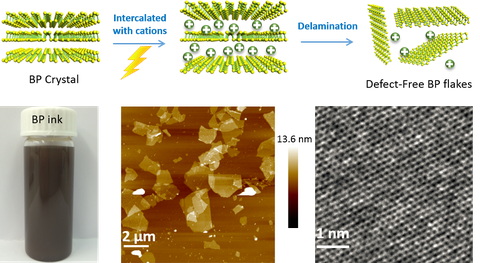23.03.2018
A Delamination Strategy for Thinly Layered Defect-Free High-Mobility Black Phosphorus Flakes
Extraordinary electronic and photonic features render black phosphorus (BP) an important material for the development of novel electronics and optoelectronics. Despite recent progress in the preparation of thinly layered BP flakes, scalable synthesis of large-size, defect-free BP flakes remains a major challenge. An electrochemical delamination strategy is demonstrated that involves intercalation of diverse cations in non-aqueous electrolytes, thereby peeling off bulk BP crystals into defect-free flakes comprising only a few layers. The interplay between tetra-n-butylammonium cations and bisulfate anions promotes a high exfoliation yield up to 78 % and large BP flakes up to 20.6 µm. Bottom-gate and bottom-contact field-effect transistors, comprising single BP flakes only a few layers thick, exhibit a high hole mobility of 252±18 cm2V-1s-1 and a remarkable on/off ratio of (1.2±0.15)×105 at 143 K under vacuum, comparable with the electronic properties of mechanically exfoliated BP flakes. This efficient and scalable delamination method opens new opportunities for the development of BP-based composites and optoelectronic devices. The related work has published in Angew. Chem. Int. Ed.
Reference:
Sheng Yang, Ke Zhang, Antonio Gaetano Ricciardulli, Panpan Zhang, Zhongquan Liao, Martin R. Lohe, Ehrenfried Zschech, Paul W. M. Blom, Wojciech Pisula, Klaus Müllen* and Xinliang Feng*, Angew. Chem. Int. Ed, 2018, DOI: 10.1002/anie.201801265
This work is financially supported by ERC grants on 2DMATER, Graphene Core 1 and EC under Graphene Flagship (NO. CNECT-ICT-604391) and Center for Advancing Electronics Dresden (cfaed).

